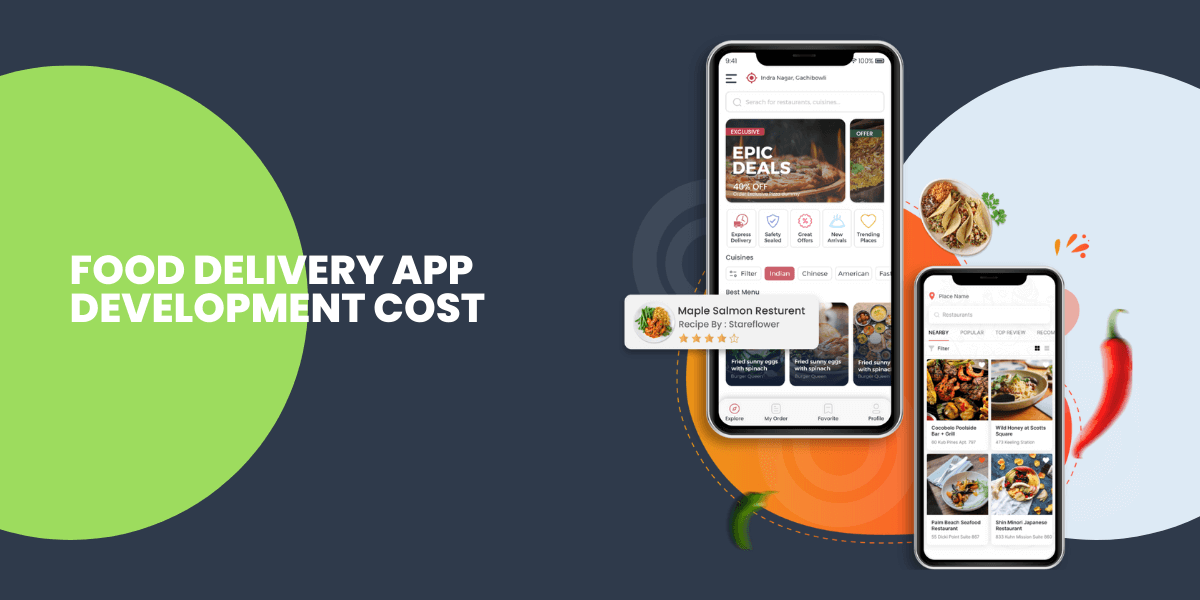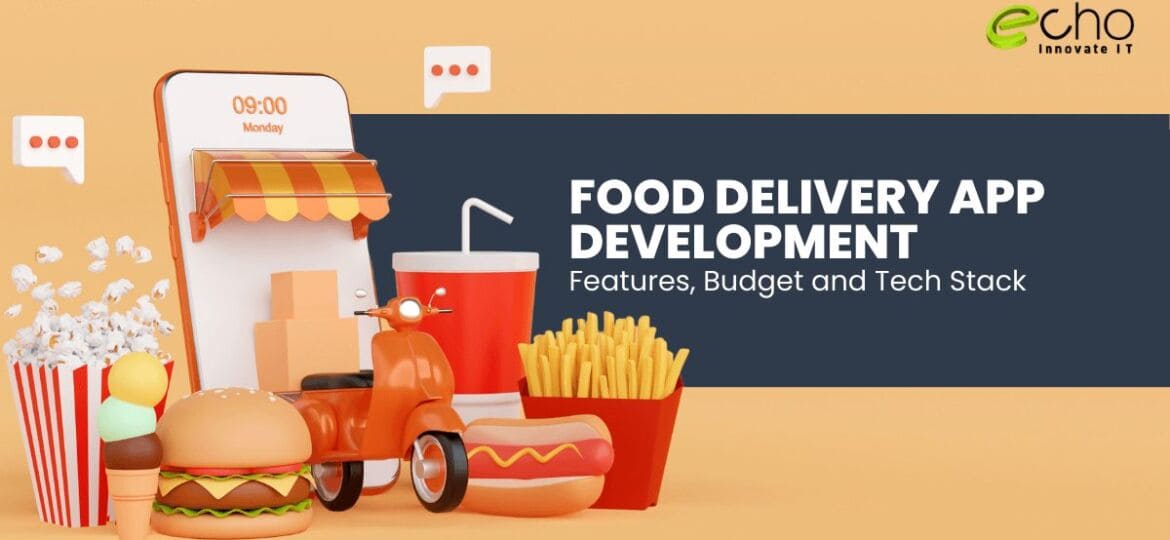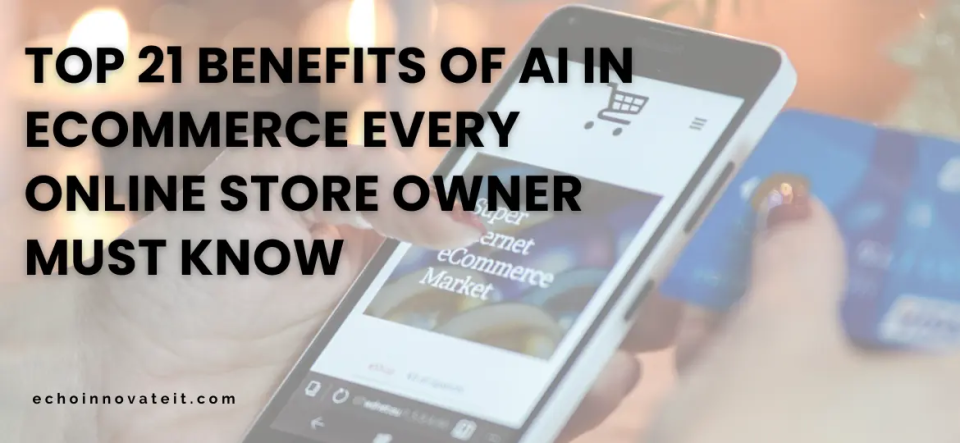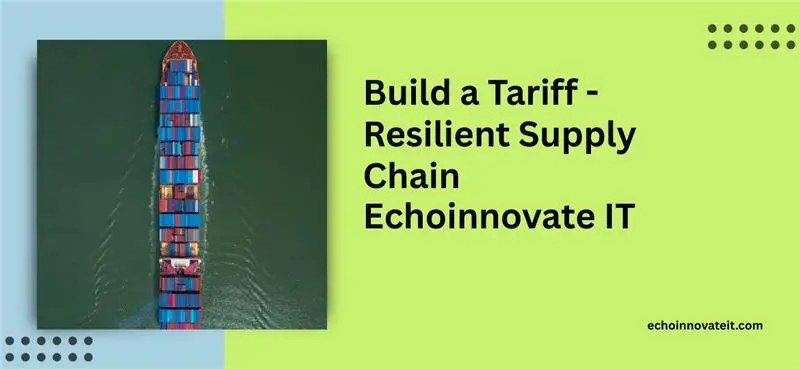How to Build a Food Delivery App in 2025: Complete Guide for Android & iOS Success
The food delivery industry in the USA continues to grow rapidly in 2025, driven by consumer demand for convenience, real-time mobile experiences, and instant gratification. Whether you’re building an Android app, an iOS app, or a cross-platform mobile solution, creating a custom food delivery application is a strategic move for startups, restaurants, or enterprises entering the on-demand market.
This comprehensive guide walks you through how to build a high-performance, scalable, and user-friendly food delivery app that aligns with current digital trends, SEO best practices, and mobile app development strategies.
Why Build a Food Delivery App in 2025?
With the global online food delivery market projected to exceed $500 billion by 2025, building a food delivery app is more relevant than ever. In the U.S. alone, mobile-first users now dominate ordering behavior, and apps that offer smooth UX, fast load times, secure payment integration, and personalized AI features win the market.
Key Reasons to Build One:
Growing demand for hyperlocal delivery
High ROI for restaurants and aggregators
Rising popularity of contactless payment and voice ordering
Shift from web-based orders to mobile-first apps (Android/iOS)
Increased use of AI, real-time tracking, and location intelligence
Core Features of a Successful Food Delivery App in 2025
To stand out in today’s mobile app market, your food delivery app must include these essential features:
1. User Panel Features
User-friendly registration via email/social login
Real-time order tracking with GPS
Smart search filters (by cuisine, rating, delivery time)
Payment integrations (Apple Pay, Google Wallet, credit cards)
In-app chat with support or delivery agents
AI-driven personalized recommendations
Voice-enabled search and order tracking (for Android and iOS apps)
2. Restaurant Panel Features
Menu management and real-time inventory updates
Order acceptance and delivery coordination tools
Analytics dashboard to track sales and customer behavior
Multi-branch support with location-specific management
Secure login and staff roles
3. Delivery Driver Panel
Live order notifications
In-app navigation and route optimization
Order history, earnings tracker, and payout management
Emergency alerts and customer contact options
4. Admin Panel Features
User, driver, and vendor management dashboard
Real-time performance analytics
Commission and promo management
Fraud detection and compliance tools
Integration with CRM, marketing automation, and loyalty platforms
Advanced Technologies Powering 2025 Food Delivery Apps
Modern mobile apps are more than just order platforms—they integrate smart tech to improve performance and usability.
AI and ML: For recommendation engines, dynamic pricing, and delivery predictions
Chatbots: In-app assistance and customer support automation
Geofencing & Route Optimization: Improved delivery accuracy and ETA tracking
Push Notifications: Personalized offers and order updates
Blockchain: Secure digital payments and transparent transactions
Cloud Infrastructure: Scalable backend architecture for high user volumes
Step-by-Step Process to Build a Food Delivery App
Step 1: Market Research and Business Model Selection
Identify your target audience—are you building for local restaurants, multi-vendor platforms, or niche cuisines? Choose the right revenue model: delivery charges, commissions, ads, or subscriptions.
Step 2: Choose Your App Type
Native Apps for Android (Kotlin) and iOS (Swift) offer top performance.
Cross-platform apps using Flutter or React Native reduce cost and time.
Progressive Web Apps (PWAs) allow lightweight access on mobile browsers.
Step 3: Design UX/UI for Mobile-First Experience
Focus on intuitive navigation, minimal steps to checkout, vibrant visuals, and fast-loading interfaces. Your app should be 100% mobile-optimized and support dark mode, voice search, and accessibility.
Step 4: Develop MVP (Minimum Viable Product)
Build an MVP to test the market with basic features. Include registration, order placing, payment integration, and real-time tracking.
Step 5: Implement Security and Compliance
Ensure PCI DSS compliance, enable end-to-end encryption, and use tokenized payments. Secure user data through two-factor authentication and GDPR compliance protocols.
Step 6: Test and Optimize for Performance
Run quality assurance tests, including device compatibility (iOS and Android), GPS tracking, push notification delivery, and server load handling.
Step 7: Deploy and Market Your App
Launch on the App Store and Google Play. Use ASO (App Store Optimization), influencer marketing, paid campaigns, and local SEO for visibility.
Monetization Strategies in 2025
Delivery Fees: Flexible based on distance or demand
Restaurant Commission: Revenue share for each order
Subscription Plans: Premium delivery or loyalty programs
In-App Ads: Sponsored restaurant listings or banners
Surge Pricing: Dynamic charges during peak hours
How Food Delivery Apps Meet 2025 E-E-A-T Standards
To comply with Google’s E-E-A-T standards:
Experience: Apps must reflect user-first design and functionality
Expertise: Developers should showcase certifications, case studies, or endorsements
Authoritativeness: Backed by industry knowledge, customer reviews, and quality assurance
Trustworthiness: Ensure app security, clear privacy policies, and user transparency
Final Thoughts: Why Mobile-First Matters in Food App Development
With the USA’s mobile app usage surging in 2025, especially for food ordering, a mobile-first strategy is essential. Apps that deliver on speed, security, personalization, and user experience will dominate. Whether you’re a startup or an established business, investing in a high-performing Android, iOS, or cross-platform food delivery app is a move toward long-term success.
Looking to build a food delivery app or create a food delivery app that stands out in today’s competitive market? We are a leading food delivery app development company offering top-notch food delivery app development services tailored to your business needs. Our experts specialize in restaurant app development, restaurant app design, and delivery app development to ensure a seamless experience for both customers and restaurant owners. Whether you need a custom food delivery app, a grocery app development solution, or a cutting-edge medicine delivery app development service, we’ve got you covered. As a trusted on demand app development company, we also build robust on demand delivery applications and offer high-quality grocery mobile app development. Our goal is to empower food businesses with scalable, user-friendly apps that help manage orders efficiently, boost revenue, and delight customers.
Food delivery mobile app development has revolutionized the lives of people all over the globe. Once upon a time, we all went outside to wait for our supper. Online food delivery app development has won the competition to develop food delivery app due to its superior user experience. As can be seen that the whole process of ordering food, which is not limited to a single cuisine, accessible with the touch and flick of a finger, on demand food delivery software is destined to be an immediate success with a large pool of mobile app users of all demographics.
The food delivery app development cost depends on the pricing model you choose and the app’s level of sophistication. It also relies on the features you choose to add in your food app development.
Overview Of The Global Food Delivery Market: Size, Growth, And Industry Statistics

Leading Food Delivery App Development Company – Empowering the Future of On-Demand Apps
In today’s fast-paced digital world, the demand for seamless food and grocery delivery experiences is skyrocketing. If you’re a startup, restaurant owner, or enterprise looking to build a food delivery app, choosing the right food delivery app development company can make all the difference.
At [Your Company Name], we specialize in providing end-to-end food delivery app development services that are scalable, customizable, and user-friendly. Whether you’re planning to create a food delivery app, launch a custom food delivery app, or build a delivery app for groceries or medicines – we have the expertise to bring your vision to life.
The convenience of on-demand app development on mobile phones has increased their adoption. The rising demand for mobile food delivery apps shows how quickly the gap between online and offline is decreasing. Consequently, in a few years, online demand will exceed offline demand.
Grocery & Medicine Delivery App Development Solutions
With the growing popularity of on-demand services, we also offer:
Grocery app development for stores and supermarkets
Grocery mobile app development to simplify shopping experiences
Advanced medicine delivery app development to help pharmacies go digital
Here are some data on food delivery app development to help you comprehend their importance.
These numbers show how technology has helped bridge offline and online meal ordering. In 2023, the U.S. trends in the food delivery industry might reach $24.461 billion with 124.4 million consumers. By 2024, the market is expected to be valued at USD 14,679 million, increasing at 9.5%.
To develop food delivery app business is expected to reach $300 billion by 2030 as smartphone technology improves and more applications are released. As a matter of fact, These apps produced $22,073 million, according to Statista. Undoubtedly, this income should reach $31,413 million by 2023. In 2027, the worldwide online food delivery app development is expected to reach 223.7 billion.
Classification Of Food Delivery Services

The cost of building a food delivery app and process is well-known. As on-demand delivery firms arise, three types of food delivery apps are in high demand. Evidently, using any kind may revolutionize your food delivery company paradigm.
To begin with, the food applications know the various categories. Food ordering apps come into three categories:
Delivery-service Aggregator:
Aggregators began 15 years ago. It’s the ‘third-party’ mobile food delivery app. This sort of business offers client service via a single app or website. Aggregator applications link clients with various nearby eateries to choose any cuisine. This service survives on restaurant commission. Customers are worry-free.
There are major participants in the aggregators industry. These online food delivery services have gained prominence. This includes app like UberEats, Food Panda and GrubHub.
Ride-hailing delivery service apps:
New ride-hailing mobile food delivery applications provide the same menu flexibility as aggregators. It’s logistics-focused, which is great. New delivery applications may aid small businesses that can’t afford their own delivery service. Therefore, it’s a great chance for eateries who have never delivered food.
This service is low-cost since there are no driver fees, car maintenance expenses, or insurance premiums. Without a doubt, the ride-hailing company is accountable. When you develop food delivery app, it benefits restaurants and consumers with a set fee per order. Food Delivery mobile applications like UberEATS, Zomato, and PostMates are delivery partners.
Full-stack delivery apps:
In this model, one service provider supports the complete food delivery business model like DoorDash. One party prepares and delivers meals to customers.
This company concept is distinct from the others and demands big money. Popular eateries has significant cost of building a food delivery app as they provide extra services to regulars. Customers may order meals from home, boosting revenue. Domino’s Pizza is the example.
Some businesses use cloud kitchens to cook. Then you pick a cloud kitchen and distribute cuisine under your own banner. The restaurant does not provide meals. Instead, they take orders on the platform and deliver the meal.
With this in mind, the customers may order from app menus. After receiving an order, the restaurant notifies the client. The restaurant’s courier brings the meal to the client when the order is ready.
Best Food Delivery Mobile App Business Models

This is a computerized Food Delivery Business Model. The app provides access to many eateries and maintains a logistical network for delivery staff.
The Order Only Model
First-generation creation of food delivery apps like JustEat, Grubhub, etc. concentrated on the first step: aggregating a fragmented offering of independent eateries (primarily takeout) that maintain their own fleet of couriers.
These software-only marketplaces provide restaurants with new orders and replace their old phone-ordering system with a Web and mobile platform that connects with their kitchen process.
These platforms charge 10-15% since they don’t prepare or deliver the meal. As pure software businesses, they’re flexible and have grown rapidly.
The Order And Delivery Model
First-generation food delivery mobile app development platforms like JustEat and Grubhub focused primarily on solving one key challenge: aggregating a fragmented network of independent restaurants—mainly takeout spots—with their own delivery fleets. These early food delivery app development services revolutionized the industry by replacing outdated phone-ordering systems with efficient web and mobile platforms. By streamlining kitchen workflows and customer interactions, they laid the groundwork for modern food app development. Today, a competitive food delivery app development company goes beyond basic aggregation to offer full-featured, scalable solutions. From restaurant app development and intuitive restaurant app design to seamless delivery app development and custom food delivery app creation, the goal is to empower restaurants with end-to-end control. We also specialize in grocery app development, grocery mobile app development, and medicine delivery app development, helping businesses build a food delivery app, create food delivery app features, or build a delivery app tailored to their needs. As an experienced on demand app development company, we deliver robust on demand delivery applications that are built for performance, reliability, and user satisfaction.
How Much Does It Cost To Develop A Food Delivery App?

We will try to answer the question, “How much does it cost to make delivery app for food?” because there are a number of factors that together add on to the estimation of delivery app development cost.
With this intention in mind, the food delivery app development cost would be anywhere between $30,000 and $40,000, based on the features you want to put in your app and the resources that would be required to get your app changed from its concept stage to the launch phase. Cost of building a food delivery app depends on the following factors:
Also Read:
Geographic Location:
Comparing agencies helps you choose one that meets your demands. First, compare food app developer hourly wages across nations. Second, ask the mobile app developer for a quotation on project completion. Developers’ rates vary by geography.
App Complexity:
Many IT businesses offer mobile app development services, but when it comes to high-quality, scalable solutions like food delivery app development, choosing the right partner is critical. A basic app may be easy to build, but a feature-rich and complex custom food delivery app demands an experienced and intellectual team. As a leading food delivery app development company, we specialize in creating robust apps that include tailored panels for customers, delivery partners, and restaurant admins. Our expertise spans across restaurant app development, restaurant app design, delivery app development, and grocery app development. We also offer solutions for medicine delivery app development, grocery mobile app development, and full-scale food app development. Whether you’re looking to build a food delivery app, create food delivery app features, or build a delivery app for your business, our team ensures seamless performance and user satisfaction. As a trusted on demand app development company, we provide end-to-end support for your on demand delivery application needs.
Features:
Non-linear operations characterize a sophisticated food delivery mobile application. If your app fits this category, hire dedicated developers to assist you. App’s UI should be straightforward so that it is easier for the consumers to access the app. You app should neither lack features, nor have too many features that confuse the users.
Mobile app design, to create a food ordering app for both the Android and iOS versions, testing, and releasing the software to the public are all included in the price range that the food delivery mobile app development business is likely to charge.
Knowing what’s in store for the on-demand app development industry will help you have more fruitful discussions while hiring mobile app developers from Echoinnovate IT about how to scale your app for the future of food delivery.
Revenue Generation Techniques For Food Delivery Applications

Markedly, there are several strategies through which online food delivery marketplace firms may create profits or money for their company food delivery marketplace platform.
Delivery charges:
Some restaurants prefer not to hire in-house delivery drivers. In such cases, they are often willing to reimburse you for using your own delivery personnel. This creates a great business opportunity—by hiring delivery staff, you can partner with multiple restaurants and charge a fee per order. To manage such operations efficiently, investing in a scalable food delivery app development solution is essential. As a leading food delivery app development company, we provide robust food delivery app development services tailored to this exact model. Our custom food delivery app can be designed to include features like delivery tracking, multiple restaurant integrations, and real-time payment processing. With expertise in delivery app development, restaurant app development, restaurant app design, and grocery app development, we help clients build a food delivery app that meets diverse business needs. From grocery mobile app development to medicine delivery app development and on demand delivery application solutions, our team has the tools to create food delivery app platforms that scale. Partner with a trusted on demand app development company to build a delivery app that truly delivers value.
Commission:
As a food app development marketplace platform owner, you may charge a set commission on each order. Nevertheless, you may negotiate various rates with restaurants to supply your platform for free, but you’ll take a fee on each order to earn money from food delivery.
Ready to Build a High-Performance Food Delivery App?
Whether you’re planning to build a food delivery app, create food delivery app features from scratch, or upgrade an existing system, our team is here to guide you every step of the way. Let us help you build a solution that works for you and your customers.
📞 Get in touch today to kickstart your journey with the best food delivery app development company in the industry.
Convenience fee:
In addition, you may charge platform users a convenience fee, who place orders on your online food delivery app. Nonetheless, the order fee is minimal. Users willingly pay as they utilize your platform from home or work.
Subscription model:
Two subscription-based revenue models are available to owners of Ready On-Demand Food Delivery Marketplace solutions. Accordingly, you may regulate a restaurant’s menu, meal orders, locations, prominent listings, branding assets like mobile applications, social media marketing, etc. with various plans. You may also offer users discounts, monthly subscriptions, and reward points. Monthly, quarterly, half-yearly, & annual.
Payment Gateway charges:
Similarly, you may also negotiate payment gateway fees for online payments. Because you’re a platform owner with many daily transactions, they’ll provide you the greatest transaction fee, which you may charge restaurants.
Marketing campaigns:
Additionally, you may give restaurant marketing strategies. Restaurant proprietors don’t have time for social media or email marketing due to their company. You may offer them alternative options and advertise their company to increase clients and orders.
Restaurant service-based pricing:
Each restaurant has its unique needs. On one hand, some restaurants can manage orders using web-based software, while others prefer a mobile food delivery app. On the other hand, some use thermal printers for order receipts, while others use the app whereas some restaurants desire a customer app. These other services might be billed separately.
Technologies To Develop Food Delivery Apps

Key app features determine the essential technology. While building a food delivery app, one must have a stable and scalable backend to manage plenty of data. App users pay for orders using integrated payment mechanisms. APIs supply extensive restaurant information, while GPS tracking devices follow orders’ travels.
What SDKs and technologies are utilized to develop food delivery apps? Food app development tech stack:
Backend
You need a robust backend to store food delivery data safely. MongoDB can develop scalable, load-balanced databases. It allows regional replication.
SMS
Proper communication ensures fast, seamless delivery. In-app messaging keeps restaurants, couriers, and customers in contact. Plivo, MessageBird, Nexmo, and others are good alternatives to Twilio.
Payment system
Each online payment mechanism is unique. Integrate a dependable payment platform. Stripe and Braintree are simple, comprehensive SDKs for online payment applications.
GPS
Food delivery apps need location-tracking technology. Consider Google’s Geolocation API for Android and iOS’s CoreLocation framework to detect user location and track orders. You may provide couriers instructions using MapKit and Google Directions APIs. Android and iOS have Google Maps.
Restaurant listing
When developing a food delivery network with various restaurants, you must offer all the necessary information, such as locations, hours, and menus. GrubHub, Zomato, and FourSquare Places provide APIs. Third-party APIs update menus and prices. Zomato API lists 1.5 million eateries in 10,000 cities.
Conclusion
Food delivery mobile app development is one of the fastest-growing trends of the preceding decade, and with the COVID-19 pandemic, it became an essential need. Investment possibilities are abundant in the business, as is competition. However, success is likely with a clever business plan and a flexible approach to product development.
When starting the development process, it is of the highest significance to have a high-performing food delivery app development company. Hire experienced app developers, Echoinnovate IT, for the most efficient approach to build such applications. By collaborating with us, you can anticipate a high-quality end product and a partner that is willing to share knowledge and provide guidance.
FAQs
What makes a good food app development?
A food delivery mobile app development is excellent if it’s straightforward, easy to use, and well-designed. Uber Eats, Deliveroo, etc. are good instances of successful food delivery mobile applications.
How long does food delivery mobile app development take?
Online food delivery app development solutions need time and resources due to the intricacy of applications. Unique features will lengthen development time, however a simple shipping solution with minimal capabilities may be produced in 1-2 months. Contact us for free consultation now!
How can we enhance our on demand food delivery app development?
These concepts and practices may enhance your app’s functionality and user experience like allowing customers to order meals anytime, anyplace, offering various payment and delivery options and more.
What is the Google SEO update 2025?
The 2025 update focuses on mobile-first content, Core Web Vitals, content authenticity, and helpful, experience-based writing. It rewards content created by verified experts and penalizes AI-generated spam.
What are the latest SEO ranking factors?
Top factors include mobile usability, page speed, E-E-A-T compliance, structured data, HTTPS security, and high-quality backlinks from authoritative domains.
How do I rank on Google in 2025?
Use mobile-first design, publish helpful and original content, optimize Core Web Vitals, apply FAQ and How-To schema, and demonstrate real user expertise.
What are the best AI SEO tools in 2025?
Top tools include SurferSEO, Jasper AI, MarketMuse, and Clearscope for content strategy, keyword optimization, and SERP analysis.
How did the July 2025 Google algorithm update impact rankings?
The update focused on mobile performance, AI content quality, voice-search compatibility, and trust signals such as author bios and updated content.
What are SEO tips for USA websites?
Use local intent keywords, create fast-loading mobile pages, apply structured data, and optimize for voice queries and conversational search.
How does voice search affect SEO?
Voice search prefers natural language, question-based phrases like “What’s the best food delivery app in 2025?” Structure your content to answer these directly.
What are Core Web Vitals in 2025?
They are page speed metrics: Largest Contentful Paint (LCP), Cumulative Layout Shift (CLS), and Interaction to Next Paint (INP). All impact your rankings, especially on mobile.



